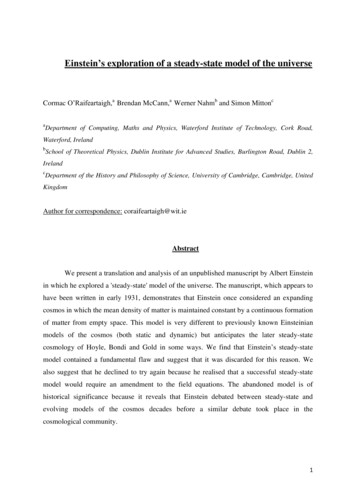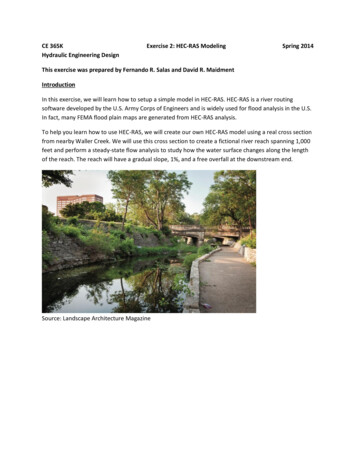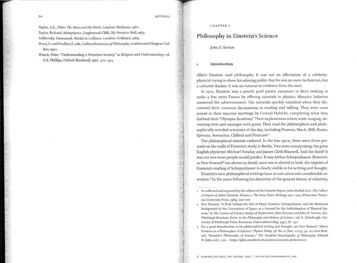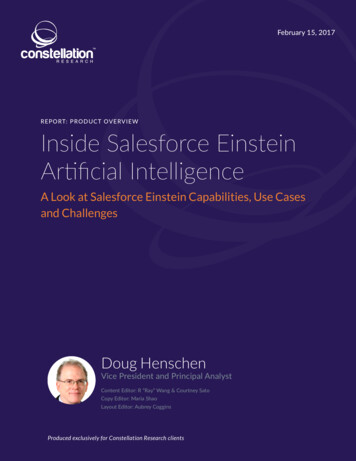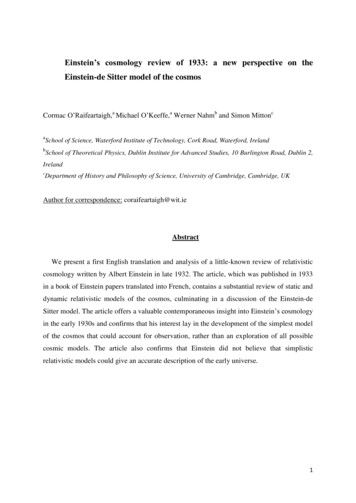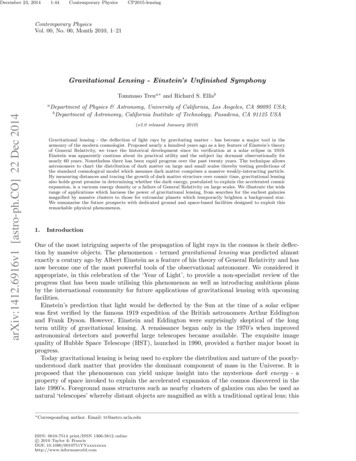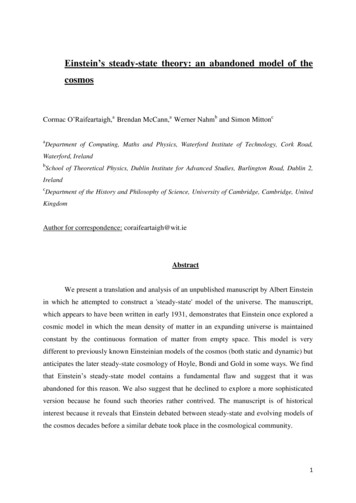
Transcription
Einstein’s steady-state theory: an abandoned model of thecosmosCormac O’Raifeartaigh,a Brendan McCann,a Werner Nahmb and Simon MittoncaDepartment of Computing, Maths and Physics, Waterford Institute of Technology, Cork Road,Waterford, IrelandbSchool of Theoretical Physics, Dublin Institute for Advanced Studies, Burlington Road, Dublin 2,IrelandcDepartment of the History and Philosophy of Science, University of Cambridge, Cambridge, UnitedKingdomAuthor for correspondence: coraifeartaigh@wit.ieAbstractWe present a translation and analysis of an unpublished manuscript by Albert Einsteinin which he attempted to construct a 'steady-state' model of the universe. The manuscript,which appears to have been written in early 1931, demonstrates that Einstein once explored acosmic model in which the mean density of matter in an expanding universe is maintainedconstant by the continuous formation of matter from empty space. This model is verydifferent to previously known Einsteinian models of the cosmos (both static and dynamic) butanticipates the later steady-state cosmology of Hoyle, Bondi and Gold in some ways. We findthat Einstein’s steady-state model contains a fundamental flaw and suggest that it wasabandoned for this reason. We also suggest that he declined to explore a more sophisticatedversion because he found such theories rather contrived. The manuscript is of historicalinterest because it reveals that Einstein debated between steady-state and evolving models ofthe cosmos decades before a similar debate took place in the cosmological community.1
1. IntroductionIn the course of our research into Einstein’s cosmology in the early 1930s,1 werecently came upon an attempted model of the cosmos that he did not publish. This model isset out in a signed, four-page handwritten manuscript entitled “Zum kosmologischenProblem” in the Albert Einstein Archives of the Hebrew University of Jerusalem (Einstein1931a). Until now,2 the manuscript was understood to be a draft of the paper “Zumkosmologischen Problem der allgemeinen Relativitätstheorie”, published by Einstein in thejournal Sitzungsberichte der Königlich Preussischen Akademie der Wissenschaften (Einstein1931b). However, on examining the manuscript we found that it features a model of thecosmos strikingly different to the Sitzungsberichte paper, despite some similarities in title andopening paragraphs (figure 1).The manuscript indicates that Einstein once explored a model of an expandinguniverse in which the density of matter remains constant due to a continuous formation ofmatter from empty space. This model is very different to other Einsteinian models of thecosmos, such as his early model of a static universe (Einstein 1917) or his later models of adynamic, evolving universe (Einstein 1931b, Einstein and de Sitter 1932). However, themodel anticipates the well-known steady-state theories of Fred Hoyle, Hermann Bondi andTommy Gold (Hoyle 1948; Bondi and Gold 1948) in some ways.We present a guided tour of Einstein’s manuscript in section 2 of our paper anddiscuss a likely date for the work in section 3. In section 4, we consider possible reasons forEinstein’s abandonment of his steady-state theory, not least a fundamental flaw in thederivation. The model is considered in the context of other steady-state theories in section 5,and in the context of Einstein’s philosophy of cosmology in section 6. We provide atranslation of the original manuscript in an Appendix by kind permission of the AlbertEinstein Archive of the Hebrew University of Jerusalem.1See (O’Raifeartaigh and McCann 2014).This point has been confirmed by John Stachel, the founding editor of the Einstein Papers Project (Stachel2013).22
2. A guided tour of the manuscript3The manuscript begins with Einstein recalling the well-known problem of gravitationalcollapse in a Newtonian universe. This starting point is similar to Einstein’s seminalcosmological paper of 1917 (Einstein 1917), although he now includes a reference to thework of Hugo Seeliger:“It is well known that the most important fundamental difficulty thatemerges when one asks how the stellar matter fills up space in very largedimensions is that the laws of gravity are not in general consistent with thehypothesis of a finite mean density of matter. Thus, at a time when Newton’stheory of gravity was still generally accepted, Seeliger had already modifiedthe Newtonian law by the introduction of a distance function that, for largedistances r, diminishes considerably faster than 1/r2.”Einstein points out that a similar problem arises in relativistic models of the cosmos, andrecalls his introduction of the cosmological constant to the field equations of relativity torender them consistent with a static universe of constant radius and matter density:“This difficulty also arises in the general theory of relativity. However, Ihave shown in the past that this can be overcome by the introduction of theso-called “λ–term” to the field equations. The field equations can then bewritten in the form()( )()At that time, I showed that these equations can be satisfied by a sphericalspace of constant radius over time, in which matter has a density ρ that isconstant over space and time.”In the next part of the manuscript, Einstein suggests that this static model now seemsunlikely:“It has since transpired that this solution is almost certainly ruled out forthe theoretical comprehension of space as it really is”We note that Einstein dismisses his static model for two separate reasons. First, he commentson the existence of dynamic solutions and notes that his static solution was found to beunstable:“On the one hand, it follows from investigations based on the sameequations by [ ] and by Tolman that there also exist spherical solutions3We suggest this section be read in conjunction with our translation of Einstein’s manuscript in the Appendix.3
with a world radius P that is variable over time, and that my solution is notstable with respect to variations of P over time.”The blank space in the sentence above representing theoreticians other than Tolman whosuggested dynamic solutions is puzzling as Einstein was unquestionably aware of thecosmological models of both Friedman and Lemaître (Nussbaumer 2014; Nussbaumer andBieri 2009, chapters 7 and 9). Einstein also neglects to make it clear which investigationshave revealed that his static solution is unstable, although this is very likely a reference toEddington’s paper on the subject (Eddington 1930; Nussbaumer 2014). These points arediscussed further in section 3.Einstein’s second reason for ruling out his former static solution concerns theastronomical observations of Edwin Hubble:“On the other hand, Hubbel’s [sic] exceedingly important investigationshave shown that the extragalactic nebulae have the following twoproperties:1) Within the bounds of observational accuracy they are uniformly distributedin space2) They possess a Doppler effect proportional to their distance”We note that Hubble’s name is misspelt throughout the manuscript, as in the case ofEinstein’s Sitzungsberichte paper of 1931 (Einstein 1931b). This may indicate that Einsteinwas not fully familiar with Hubble’s work, as has been previously argued (Nussbaumer 2014;O’Raifeartaigh and McCann 2014). We also note that Einstein uses the term ‘Doppler effect’rather than radial velocity, suggesting a qualified acceptance of Hubble’s observations asevidence for a cosmic expansion.Remarking that the dynamic models of de Sitter and Tolman are consistent withHubble’s observations, Einstein points out that their models predict an age for the cosmosthat is problematic:“De Sitter and Tolman have already shown that there are solutions toequations (1) that can account for these observations. However the difficultyarose that the theory unvaryingly led to a beginning in time about 1010-1011years ago, which for various reasons seemed unacceptable.”We note that there is again no reference to the evolving models of Friedman or Lemaître .The “various reasons” in the quote is almost certainly a reference to the fact that the estimatedtimespan of dynamic models was not larger than the ages of stars as estimated from4
astrophysics, or the age of the earth as estimated from radioactivity.4 However, the sentenceis a little ambiguous; it is possible that Einstein’s “difficulty” also refers to the very notion ofa “beginning in time” for the universe. Indeed, it is quite curious that the problem of origins isnot specifically discussed in the manuscript (see section 3 below).In the third part of the manuscript, Einstein explores an alternative solution to thefield equations that could also be compatible with Hubble’s observations – namely, anexpanding universe in which the density of matter does not change over time:“In what follows, I wish to draw attention to a solution to equation (1) thatcan account for Hubbel’s [sic] facts, and in which the density is constantover time. While this solution is included in Tolman’s general scheme, itdoes not appear to have been taken into consideration thus far.”The reference to “Tolman’s general scheme’’ is significant as Einstein’s ensuing analysisbears some technical similarities to a paper by Tolman in which the latter associated thecosmic expansion with a continuous transformation of matter into radiation (Tolman 1930).Einstein starts the construction of his model by choosing the metric of flat spaceexpanding exponentially:“I leteαt()( )This manifold is spatially Euclidean. Measured by [this] yardstick, thedistance between two points increases over time as; one can thusaccount for Hubbel’s Doppler effect by giving the masses (thought of asuniformly distributed) constant co-ordinates over time.”Equation (2) represents the line element of the de Sitter universe in its simplest form.5 Asimilar line element was employed by Tolman in the paper mentioned above (Tolman 1930)and Einstein’s choice of metric may have been influenced by that work. However, it can beshown that the hypothesis of a constant rate of matter creation requires a metric that isspatially flat and exponentially expanding and Einstein may have realised thisindependently.64Einstein’s view of the timescale problem is spelt out in detail in his later review of dynamic models (Einstein1945).5This was first shown by Robertson in 1928 (Robertson 1928).6A constant rate of matter creation requires spatial flatness (k 0) because the creation rate is related to spatialcurvature (k/R2) and the radius is not constant. A constant Hubble parameter ̇ is also required, from which itfollows that the expansion must be exponential.5
Einstein notes that the metric is invariant:“Finally, the metric of this manifold is constant over time. For it istransformed by applying the substitutiont' t - τ (τ const)intoeαt’ ()We note the apparent sign error in the last equation above, an error that may have led to amiscalculation in the derivation to follow.Assuming a low velocity of masses relative to the co-ordinate system and negligibleradiation pressure, Einstein constructs a matter-energy tensor in a manner analogous to hisseminal paper of 1917 (Einstein 1917):“We ignore the velocities of the masses relative to the co-ordinate system aswell as the gravitational effect of the radiation pressure. The matter tensoris then to be expressed in the form()or( )where.”From equations (1) - (3), he derives two simultaneous equations and eliminates thecosmological constant to solve for the matter density:“ Equations (1) yield:or( )”Thus, Einstein has derived an expression for the matter density ρ in terms of the expansionco-efficient α. However, we note an ambiguity regarding the coefficient of α2 in the first of6
the simultaneous equations (see figure 2). While a value of 9/4 for this coefficient is impliedby equation (4), it appears to have been later amended to -3/4, a correction that leads to thenull solution ρ 0 instead of equation (4), exposing a fundamental flaw in the model (seesection 4).Before amending the analysis above, Einstein concluded from equation (4) that thedensity of matter remains constant and is related to the cosmic expansion:“The density is therefore constant and determines the expansion apart fromits sign.”Thus, Einstein associates the cosmic expansion with a continuous creation of matter, whileTolman suggested that the expansion was driven by a transformation of matter into radiation(Tolman 1930).In the final part of the manuscript, Einstein proposes a physical mechanism to allowthe density of matter remain constant in a universe of expanding radius - namely, thecontinuous formation of matter from empty space:“If one considers a physically bounded volume, particles of matter will becontinually leaving it. For the density to remain constant, new particles ofmatter must be continually formed within that volume from space.”This proposal anticipates the ‘creation field’ of Fred Hoyle in some ways (see section 5below). However, unlike Hoyle, Einstein has not introduced a term representing this‘creation’ process into the field equations (1). Instead he loosely associates the continuousformation of matter with the cosmological constant, suggesting that the latter ensures that theconservation of energy is not violated:“The conservation law is preserved in that, by setting the λ-term, spaceitself is not empty of energy; its validity is well-known to be guaranteed byequations (1).”Thus, in this model of the cosmos, Einstein proposes that the cosmological constant assignsan energy to empty space that is associated with the creation of matter. However, the model isfundamentally flawed because the lack of a specific term representing matter creation leads tothe null solution ρ 0. We suggest that Einstein recognized this problem on revision of themanuscript and set the model aside rather than pursue more contrived steady-state solutions,as discussed in section 6.7
3. Historical remarks: dating the manuscriptThe manuscript under discussion has been assigned the year 1931 by the AlbertEinstein Archive. However, this dating is no longer certain as the manuscript was mistakenfor a draft of a different paper until now (see introduction).It is instructive to attempt to date the manuscript from its contents. The statement“Hubbel’s [sic] exceedingly important investigations have shown that the extra-galactic nebulae possess a Doppler effect proportional to their distance” (section 2) gives confidence that themanuscript was written after Hubble’s seminal publication of 1929 (Hubble 1929) as it isvery unlikely that Einstein knew of Hubble’s observations before this date (Nussbaumer2014). Indeed, it is generally thought that Einstein’s interest in cosmology was rekindled byHubble’s observations of the recession of the galaxies, and by his three-month stay in theUnited States from December 1930 to March 1931. Much of this trip was spent at Caltech,and included a meeting with Edwin Hubble and other astronomers at the Mount WilsonObservatory (Nussbaumer and Bieri 2009, chapter 14; Bartusiak 2009, p251-256; Eisinger2011, p 109-115). Press reports of seminars given by Einstein at Caltech certainly suggestthat he viewed Hubble’s observations as likely evidence for an expanding universe. Forexample, The New York Times reported Einstein as commenting that “New observations byHubble and Humason concerning the redshift of light in distant nebulae make the presumptions nearthat the general structure of the universe is not static” (AP 1931a) and “The redshift of the distantnebulae have smashed my old construction like a hammer blow”(AP 1931b).Einstein had many interactions with the theoretician Richard Tolman at Caltech andgreatly admired Tolman’s work on relativity (Nussbaumer 2014; Nussbaumer and Bieri 2009,p145-147; Eisinger 2011, p114). Thus, Einstein may have been influenced by Tolman’scosmology; as noted in section 2, the manuscript under discussion bears some similarities toTolman’s ‘annihilation’ model of 1930 (Tolman 1930). Finally, Einstein’s manuscript iswritten on American paper,7 making it unlikely that it was written before his arrival in theUnited States in January 1931.As regards an upper bound for the date of the manuscript, we note that it is verydifferent in both style and content to the cosmic models published by Einstein in April 1931(Einstein 1931b)8 and 1932 (Einstein and de Sitter 1932). In the latter papers (known as the78We thank Barbara Wolff of the Albert Einstein Archives for confirming this point.It is known that this model was written in early April 1931 (see Eisinger 2011) chap 7.8
Friedman-Einstein and the Einstein-de Sitter models respectively), Einstein assumed that themean density of matter varied with varying cosmic radius, and he removed the cosmologicalconstant term from the field equations, pointing out that it was only introduced to keep theuniverse static. These ‘evolving’ models of the cosmos were not constructed from firstprinciples, but employed the earlier analysis of Alexander Friedman; further, Einstein usedFriedman’s differential equations in conjunction with Hubble’s observations to determinevalues for the radius and matter density of the universe (Einstein 1931b, Einstein and deSitter 1932).By contrast, the model in the manuscript under discussion is constructed from firstprinciples; the cosmological constant is not removed from the field equations and there is noreference to Friedman’s analysis or to Einstein’s evolving models of 1931 and 1932. We alsonote that there is no reference in the manuscript to the problem of cosmic origins articulatedby Lemaȋtre in 1931 (Lemaȋtre 1931). Thus, it seems likely that the manuscript precedes theFriedman-Einstein and Einstein-de Sitter models, i.e., was written sometime in early 1931,and represents Einstein’s first attempt at a cosmic model in the wake of emerging evidencefor a cosmic expansion on the largest scales.94. Why was Einstein’s steady-state model not published?We note first that there is no mention of steady-state solutions in Einstein’s laterdiscussions of cosmic models (Einstein 1931b, Einstein and de Sitter 1932, Einstein 1945),nor have we been able to find a reference to the manuscript under discussion in Einstein’sletters, diaries or other personal papers. This apparent silence indicates that he decidedagainst the model, rather than simply mislaid the manuscript during his travels or neglected topublish it.We suggest that Einstein’s steady-state model was abandoned because it contains afundamental flaw. In particular, we have been unable to reproduce Einstein’s derivation ofequation (4) from equations (1) - (3). Attempting to derive the simultaneous equations fromfirst principles, we find a value of -3/4 for the coefficient of α2 in the first of the simultaneousequations, leading to the null solution ρ 0 instead of equation (4). Close scrutiny of figure 2suggests that the co-efficient of α2 in the first equation has indeed been amended to -3/4; it9We should emphasise that, in the absence of any definitive documentary evidence, this dating cannot becertain.9
seems that Einstein discovered his initial error at a later point, realised the model led to atrivial solution and set the work aside without correcting equation (4).10With modern eyes, it is easy to see why Einstein’s steady-state model leads to a nullsolution; the fundamental problem is that he has not included a term in the analysisrepresenting the hypothesised creation of matter. This leads one to ask why Einstein did notattempt a more sophisticated steady-state solution; we suggest that he may have decided thatsuch an approach was overly contrived in comparison with evolving models, as discussed insection 6.5. On steady-state models of the cosmosWe note first that diverse models of a ‘steady-state’ universe were advancedthroughout the 20th century. In 1918, the American physicist William MacMillan proposed acontinuous creation of matter from radiation in order to avoid a gradual ‘running down’ ofthe cosmos due to the conversion of matter into energy in stellar processes (MacMillan 1918,1925). MacMillan’s proposal was enthusiastically received by Robert Millikan, whosuggested that the process might be the origin of cosmic rays (Millikan 1928). The idea of acontinuous creation of matter from radiation was also considered by Richard Tolman as ameans of introducing matter into the empty de Sitter universe, although he saw the idea asrather improbable (Tolman 1929).Other physicists considered the possibility of the creation of matter from empty space.In 1928, James Jeans speculated that matter was continuously created in the centre of thespiral nebulae: “The type of conjecture which presents itself, somewhat insistently, is that the centresof the nebulae are of the nature of “singular points”, at which matter is poured into our universe fromsome other spatial dimension .so that they appear as points at which matter is poured into ouruniverse from some other, and entirely extraneous spatial dimension, so that, to a denizen of ouruniverse, they appear as points at which matter is continually created” (Jeans 1928, p360). Similarideas of continuous creation were explored by the Swedish scientist Svante Arrhenius and the10Attempting to reconstruct Einstein’s analysis, we take(all other components zero) and from the2time component of equation (1) we obtain (). On analysis, this gives - 3α2 /4 3α2 /2 - λc2 κρc2, the second of Einstein’s simultaneous equations. From the spatial component of equation (1),we obtain (), which on analysis gives 3α2 /4 - 3α2 /2 λc2 0 for the first of thesimultaneous equations. It is plausible that Einstein made a sign error here, initially getting 3α2/4 3α2/2 λc2 0 for this equation.10
German chemist Walther Nernst (Arrhenius 1908, 1909; Nernst 1928). However, thesetheories did not concern the creation of matter in an expanding universe.11The concept of an expanding universe that remains in a steady state due to acontinuous creation of matter is most strongly associated with the Cambridge physicists FredHoyle, Hermann Bondi and Thomas Gold. In the late 1940s, these scientists became scepticalof the evolutionary, Friedman-like models of the cosmos that had been proposed in the wakeof Hubble’s observations. They disliked Lemaȋtre’s idea of an explosive beginning for theuniverse (Lemaȋtre 1931) and noted that the evolving models predicted an age for the cosmosthat was problematic. They were also concerned that evolutionary models necessitatedspeculations about physical processes in the distant past that could not be tested directly(Hoyle 1948; Bondi 1952, chapter 12; Narlikar 1988, chapter 7). In order to circumvent thesedifficulties, the Cambridge trio explored the idea of an expanding universe that does notevolve over time, i.e., a cosmos in which the mean density of matter is maintained constantby a continuous creation of matter from the vacuum (Hoyle 1948; Bondi and Gold 1948).In the case of Bondi and Gold, the proposal of a steady-state cosmos followed fromtheir belief in the ‘perfect cosmological principle’, a philosophical principle that proposedthat the universe should appear essentially the same to observers in all places at all times.This principle led them to postulate a continuous creation of matter in order to sustain anunchanging universe. While the idea bears some similarity to Einstein’s attempt at a steadystate theory, it is difficult to compare the models directly because the Bondi-Gold theory wasnot formulated in the context of general relativity.12On the other hand, Fred Hoyle constructed a steady-state model of the cosmos bymeans of a daring modification of the Einstein field equations (Hoyle 1948, Mitton 2005,chapter 5). Replacing Einstein’s cosmological constant with a scalar field Cik, representingthe continuous creation of matter from the vacuum, Hoyle obtained the equation()( )In this model, the expansion of space was driven by the creation of matter and the perfectcosmological principle emerged as a consequence rather than a starting assumption (Hoyle11See (Kragh 1996) p143-162 for a review of steady-state cosmologies in the early 20th century.The Bondi-Gold model was based on kinematic relativity because they were not convinced that generalrelativity could be applied to the cosmos on the largest scales (Bondi 1952, p145-146).1211
1948).13 In its initial form, Hoyle’s model violated the principle of conservation of energy,but a more sophisticated version was advanced in later years (Hoyle and Narlikar 1962). Inthe latter model, matter creation was achieved via the introduction of negative stresses in theenergy-momentum tensor on the right-hand side of the field equations.14 An elegantmathematical formulation of the theory was then achieved using the principle of least action,as suggested by the Cambridge physicist Maurice Pryce (Hoyle and Narlikar 1962).The steady-state model attempted by Einstein in the manuscript under discussionanticipates that of Hoyle in some respects, but the crucial difference is that Einstein did notintroduce a term representing the creation of matter to the field equations (1), either on theleft-hand side in the manner of Hoyle’s initial model (Hoyle 1948) or on the right-hand sidein the manner of the later Hoyle-Narlikar model (Hoyle and Narlikar 1962). This keyomission led directly to the failure of Einstein’s model; as discussed in section 6, it isinteresting that he declined to explore more sophisticated steady-state models.As is well known, a significant debate developed between steady-state and evolvingtheories of the cosmos during the 1950s and 1960s (Kragh 1996, chapter 5; Mitton 2005,chapter 7). Eventually, steady-state models were ruled out by astronomical observations thatshowed unequivocally that we inhabit a universe that is evolving over time.15 We note thatthere is no evidence to suggest that any of the steady-state theorists above were aware of themanuscript under discussion; no doubt they would have been greatly interested to know thatEinstein once considered a steady-state model of the cosmos.6. On Einstein’s philosophy of cosmologyIt should come as no great surprise that, when confronted with empirical evidence foran expanding universe, Einstein once considered a stationary or steady-state model of theexpanding cosmos. There is a great deal of evidence that Einstein’s philosophical preferencewas for an unchanging universe, from his introduction of the cosmological constant to thefield equations in 1917 to keep the universe static16 to his well-known hostility to the13We note in passing that Hoyle also demonstrated that the model required a line element of the de Sitter form.This approach was first suggested by W. H. McCrea (McCrea 1951).15The key results were the observation of the distribution of galaxies in the distant past and the discovery of thecosmic microwave background (Kragh 1996, chaper 7).16While Einstein cited the low velocities of the stars in his static model (Einstein 1917), his choice was as muchphilosophical as empirical because there was no guarantee that a cosmic expansion would be detectable byastronomy.1412
dynamic models of Friedman and Lemaître when they were first suggested (Nussbaumer andBieri 2009, chapters 7 and 9). Indeed, a model of an expanding cosmos in which the densityof matter remains unchanged seems a natural successor to Einstein’s static model of 1917,from a philosophical point of view.However, such a steady-state theory requires the assumption of a continuous creationof matter and, as Einstein discovered, a successful model of the latter process was notpossible without amending the field equations. On the other hand, an expanding universe ofvarying matter density could be described without any such amendment – and indeed withoutthe cosmological constant, as Einstein proposed in the Friedman-Einstein and Einstein-deSitter models (Einstein 1931b; Einstein and de Sitter 1932). It is therefore very probable thatEinstein decided against steady-state models of the cosmos because they were more contrivedthan evolutionary models. This suggestion fits very well with our view of Einstein’sminimalist approach to cosmology in these years.17It is also possible that Einstein decided against steady-state models on empiricalgrounds, i.e., on the grounds that there was no observational evidence to support the postulateof a continuous formation of matter from empty space. It is interesting that, when asked tocomment on Hoyle’s steady-state model in later years, Einstein is reported to have dismissedthe theory as “romantic speculation” (Michelmore 1962, p253). This criticism is confirmed in aletter written by Einstein to the physicist Jean Jacques Fehr in 1952. Einstein seems highlysceptical of Hoyle’s model, and in particular of the postulate of a continuous creation ofmatter from the vacuum: “Die kosmologischen Spekulationen von Herrn Hoyle, welche eine Entstehungvon Atomen aus dem Raum voraussetzen, sind nach meiner Ansicht viel zu wenig begründet, um ernstgenommen zu werden”or “The cosmological speculations of Mr Hoyle, which presume the creation ofatoms from space, are in my view much too poorly grounded to be taken seriously” (Einstein1952).18As pointed out in section 5, steady-state models of the cosmos were eventually ruledout by astronomical observation. Nevertheless, the model of this manuscript is of someinterest in the study of Einstein’s cosmology. In the first instance, it is significant thatEinstein retained the cosmological constant in at least one cosmic model he proposed after17Two of us have previously argued that Einstein’s removal of the cosmological constant in 1931, followed byhis removal of spatial curvature in 1932, suggests an Occam’s razor approach to cosmology (O’Raifeartaigh andMcCann, 2014).18We thank Barbara Wolff of the Albert Einstein Archives for bringing this documen
1 Einstein’s steady-state theory: an abandoned model of the cosmos Cormac O’Raifeartaigh,a Brendan McCann,a Werner Nahmb and Simon Mittonc aDepartment of Computing, Maths and Physics, Waterford Institute of Technology, Cork Road, Waterford, Ireland bSchool of Theoretical Physics, Dublin I
